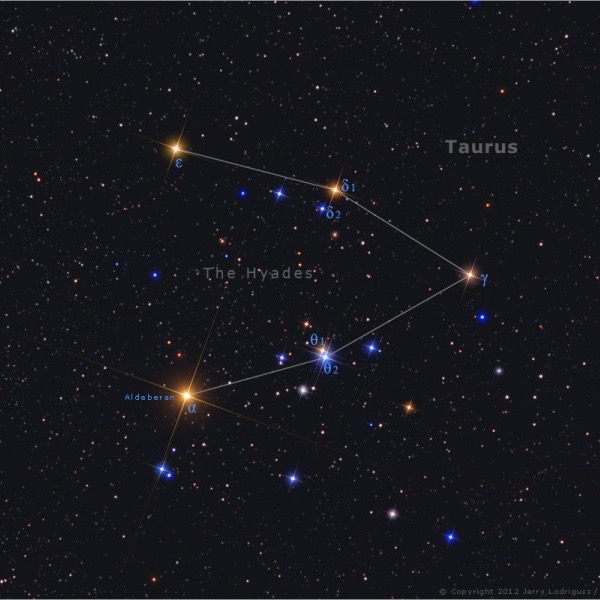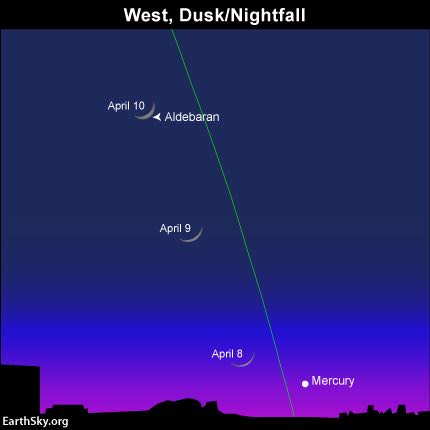
Copyright 2012 Jerry Lodriguss.
Tonight – April 9, 2016 – as darkness falls, look for the waxing crescent moon in between the bright reddish star Aldebaran in the constellation Taurus the Bull – part of the V-shaped Hyades star cluster – and the planet Mercury. The lit side of the moon points to Mercury near the horizon, which should become visible to your unaided eye about an hour after sunset. See chart below.
Binoculars will let you spot Mercury all the sooner after sundown. Once again, rely on the lit side of the moon to point in the direction of Mercury, which will plunge beneath the horizon around nightfall, or about 90 minutes after sunset at mid-northern latitudes.
Meanwhile, Aldebaran will be above the April 9 moon in the evening twilight sky. Aldebaran depicts the Eye of the Bull in Taurus, and the V-shaped Hyades star cluster depicts the Bull’s Face.
Although the moon appears to move westward with the stars of Taurus in the evening hours, the waxing crescent moon is actually orbiting the Earth eastward. For this reason, you’ll see a wider waxing crescent moon closer to the star Aldebaran as darkness falls tomorrow, April 10.
If you’re on the right spot on Earth, watch for the moon to pass in front of Aldebaran on April 10. Astronomers call this an occultation of Aldebaran.
Be sure to catch the moon and stars of Taurus at nightfall and early evening on these nights, while they’re highest in the sky. As the Earth turns eastward on its axis, the moon and Taurus will sink westward, to plunge beneath the horizon by mid-to-late evening.

The constellation Taurus the Bull’s really has two prominent signposts: the bright red star Aldebaran in its V-shaped Hyades cluster, and the dipper-shaped Pleiades star cluster.
Don’t forget to turn your binoculars on these objects, too. They’re bound to enhance the view, and you’ll be amazed how spectacular the moon, and the Pleiades and Hyades star clusters, appear in binoculars.


Also, use your binoculars to scan along the moon’s terminator line, the shadow line dividing the lunar day from the lunar night. The contrast of light and shadow along the terminator gives you the best three-dimensional view of the lunar surface.
The terminator also shows you where it’s sunrise on the moon whenever the moon is waxing from new moon to full moon, as it is now.
You might also see earthshine on the nighttime side of the moon, with or without binoculars. Earthshine is sunlight reflected from the Earth and back to the moon.
Enjoy the constellation Taurus on these April evenings. This constellation will sink into the glare of sunset in May. That’s because the sun’s annual passing in front of the constellation Taurus the Bull will occur from May 14 until June 21, 2015.
Bottom line: In early April, 2016, use the moon to find the planet Mercury, the Pleiades and Hyades star clusters plus the red giant star Aldebaran. All of these stars are in the constellation Taurus the Bull.











